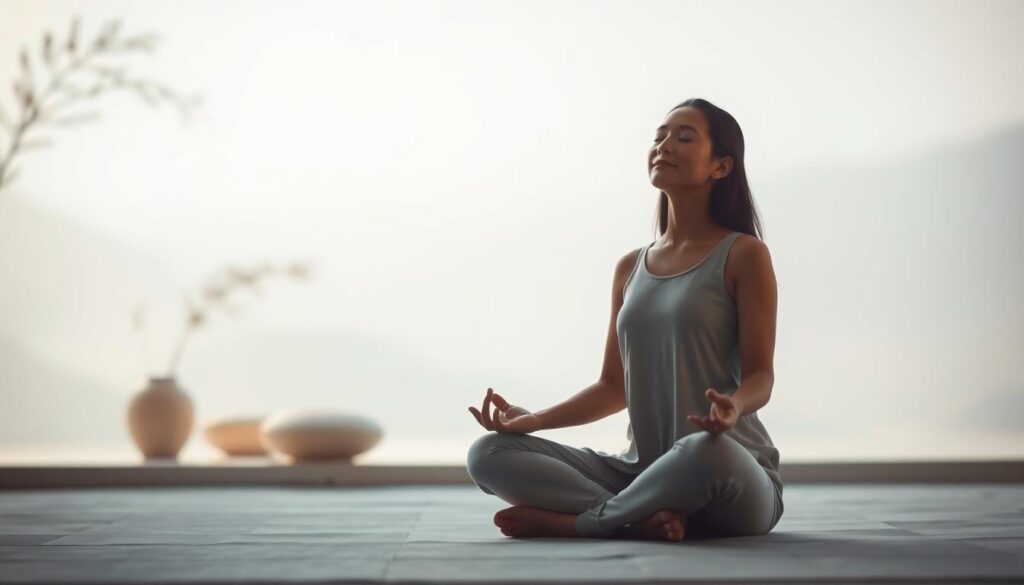Meditation: 10 Simple Techniques to Calm Your Mind Daily
Table of Contents
Life moves fast, filled with notifications, deadlines, and endless tasks. Your mind is always racing, and finding peace seems hard. But, meditation could be your secret to calm and clarity.
Mindfulness is more than just a trend. It’s backed by science to lower stress and boost emotional health. Dr. Jon Kabat-Zinn’s work at the Stress Reduction Clinic showed meditation’s power to change how we handle stress and emotions.
Think of meditation as a tool to lower blood pressure, reduce anxiety, and face life’s challenges better. These 10 meditation techniques are easy to add to your daily routine. They offer a path to relaxation and mental peace.
Key Takeaways
- Meditation is a proven technique for stress reduction
- Even 5 minutes of daily practice can create significant benefits
- Multiple meditation styles exist for different needs
- Scientific research supports meditation’s mental health benefits
- Anyone can learn and practice meditation techniques
Understanding the Power of Meditation
Meditation is a powerful spiritual practice that boosts your mental and physical health. Just a few minutes each day can lead to amazing stress relief and inner peace.
Scientific studies show meditation’s strong effects. Here are some key findings:
- 23% better attention span for regular meditators
- 60% less stress after starting
- 10% less anxiety with one minute of meditation
- 30% better sleep quality with daily practice
Benefits of Regular Practice
Meditation is more than just relaxing. It’s a deep dive into wellness. Regulars see big boosts in mental clarity, emotional balance, and happiness.
| Meditation Duration | Reported Benefits |
|---|---|
| 10 minutes daily | 50% more well-being |
| Consistent practice | 65% better emotional stability |
| Mindfulness techniques | 32% less stress hormone |
Science Behind Meditation
Neuroscience shows meditation changes your brain. Scans reveal more gray matter in areas for learning, memory, and emotions.
Impact on Mental Health
Meditation greatly improves mental health. 40% of daily meditators see big mental health gains. It’s a strong ally for mental well-being.
“Meditation is not about stopping thoughts, but recognizing that you are more than your thoughts and your feelings.” – Arianna Huffington
Essential Requirements for Starting Your Practice
Starting a meditation journey doesn’t need fancy gear or hard techniques. What’s key is your focus and awareness. Studies show even short meditation can boost mental health.
To start your meditation, consider these basics:
- Find a quiet, comfy spot at home
- Set a regular time for daily practice
- Begin with short, easy sessions
- Choose simple poses that support your body
Research shows beginners can see real benefits with 5-10 minutes a day. It’s about being consistent, not how long you meditate. Lally et al. (2010) found it takes about 66 days to form a habit, so be patient.
Your meditation spot should be:
- Quiet and free from distractions
- Comfortable temperature
- Simple decor to avoid too much visual stuff
- Personal and welcoming
Experts say set achievable goals. Aim for 3-4 five-minute sessions a week. As you get better, longer sessions will feel easier.
Remember, meditation is a personal journey. What works for one person might not work exactly the same for another.
Don’t worry if your mind drifts off. It’s normal, especially when you’re starting. The goal is to gently bring your focus back to the present, not to be perfectly still.
To get better results, you can benefit from the benefits of this nutritional supplement
Mindfulness Meditation Fundamentals
Mindfulness meditation changes how you think and feel. It helps you connect with yourself and the now. This practice is powerful.
Studies show great benefits from regular mindfulness. It can lower stress by up to 30% and boost focus by about 16%.
Developing the Right Posture
Your body position is key for mindfulness meditation. It affects your focus and awareness.
- Sit comfortably with a straight spine
- Choose a stable chair or cushion
- Keep your shoulders relaxed
- Rest hands gently on your lap
Creating Your Meditation Space
Your meditation area is important. Pick a quiet, calm spot for your practice.
| Environment Factor | Recommended Setup |
|---|---|
| Lighting | Soft, natural light |
| Temperature | Comfortable and neutral |
| Noise Level | Minimal external sounds |
Optimal Practice Timing
When you meditate matters. Early morning or before bed is best for focus and awareness.
- Morning: Start your day with clarity
- Evening: Release daily stress
- Midday: Reset and recharge
Mindfulness takes time to get better. Be kind to yourself and enjoy each moment.
Body Scan Meditation for Deep Relaxation

Body scan meditation is a great way to relax and connect with your body. It helps you notice and release tension. By focusing on each part of your body, you can feel more relaxed and well.
This practice is good for both your mind and body. Studies show it can cut stress by up to 60% and boost emotional awareness. People also feel more relaxed and kind to themselves.
- Reduces muscle tension
- Enhances body awareness
- Promotes deep relaxation
- Supports emotional regulation
“Meditation is not about stopping thoughts, but recognizing that we are more than our thoughts and our feelings.” – Arianna Huffington
To start body scan meditation, follow these steps:
- Find a quiet, comfy spot
- Lie down or sit easy
- Close your eyes and breathe deeply
- Focus on your toes, then move up
- Feel any sensations without judging
- Let go of tension as you scan
Regular practice can change how you handle stress. Just 10 minutes a day can make you feel 30% more relaxed. It helps you stay aware of your body and manage stress better.
Try apps like Insight Timer for guided meditations. They can help you deepen your practice. With effort, you can see big changes in how you feel.
Breathing Techniques for Inner Peace
Breath control is a powerful tool for managing stress and achieving relaxation. By understanding and practicing specific breathing techniques, you can transform your mental and physical well-being in just minutes a day.
Modern life bombards us with constant stressors. The good news is that your breath can be your most accessible and immediate stress relief mechanism. Research shows that targeted breathing exercises can significantly reduce anxiety and promote inner calm.
Different Breathing Patterns
Explore these transformative breathing techniques designed to help you manage stress:
- 4-7-8 Breathing: Inhale for 4 seconds, hold for 7 seconds, exhale for 8 seconds
- Alternate Nostril Breathing: Enhances cardiovascular function and lowers heart rate
- Resonant Breathing: Five complete breaths per minute to maximize heart rate variability
Managing Stress Through Breath
| Technique | Duration | Primary Benefit |
|---|---|---|
| Diaphragmatic Breathing | 5-10 minutes, 3-4 times daily | Reduces stress, supports respiratory health |
| Humming Bee Breath | 5-10 minutes | Lowers heart rate, reduces anxiety |
| Equal Breathing | 5 minutes minimum | Improves mental well-being |
Incorporating Breath Work Daily
Start small with just 5-10 minutes of dedicated breath work. Choose a consistent time – perhaps morning or before bed – to build a sustainable relaxation practice. Remember, the goal is not perfection but progress in your stress management journey.
Your breath is a bridge between your mind and body – learn to cross it consciously.
Guided Imagery and Visualization Practice

Guided imagery is a strong meditation method that changes your mind’s view. It offers a special way to find calm and inner peace. By using your imagination, you can build a mental haven that helps with stress and emotional healing.
Research shows great benefits from this meditation method. Studies show that guided imagery can:
- Increase alpha brain waves linked to a relaxed mood
- Lower stress and anxiety levels
- Boost the immune system
- Enhance mental health overall
To start guided imagery meditation, follow these easy steps:
- Find a quiet, comfy spot
- Close your eyes and breathe deeply
- Picture a peaceful place
- Use all your senses in the scene
- Stay in this mental space for 10-15 minutes
Your visualization can take you to serene landscapes like calm beaches, green forests, or mountain escapes. The goal is to create a personal mental haven that encourages deep relaxation and helps you avoid daily stress.
Guided imagery is like a mini-vacation for your mind, offering therapeutic benefits without leaving your home.
People say it greatly helps with managing stress, controlling emotions, and improving mental clarity. With regular practice, you can build a strong tool for finding meditation and inner peace.
Loving-Kindness Meditation for Emotional Balance
Loving-kindness meditation is a powerful spiritual practice. It can change your emotional world. This meditation helps you grow compassion, find inner peace, and become emotionally strong through mental training.
This meditation, known as Metta meditation, aims to create positive feelings towards yourself and others. The practice systematically develops an attitude of loving acceptance. This can change how you see the world.
Steps to Practice Metta Meditation
- Find a comfortable, quiet meditation space
- Sit in a relaxed posture with eyes closed
- Begin by directing kind thoughts to yourself
- Gradually extend compassion to loved ones
- Expand feelings of kindness to neutral individuals
- Finally, include those you find challenging
Cultivating Compassion
Meditation research shows its amazing benefits.
“Hatred cannot coexist with loving-kindness,” as the Dhammapada wisely states, highlighting the transformative power of this technique.
Building Emotional Resilience
Regular loving-kindness meditation boosts your emotional health. Studies show 13 minutes of daily meditation can improve attention, memory, and lower stress. By practicing this meditation, you’ll become more emotionally flexible and understanding.
Your journey with loving-kindness meditation leads to deeper self-awareness and connection. Start with short sessions and increase your practice time. This will bring you emotional balance and inner peace.
Walking Meditation and Movement Practices

Walking meditation turns your daily walks into a mindfulness practice. It’s different from sitting meditation because you move while focusing. Studies show that 10 to 20 minutes of mindful walking can make you feel better and lower stress.
Meditation while walking is great for those who can’t sit still. It connects your body and mind through movement. Research shows it can:
- Reduce anxiety by up to 30%
- Improve emotional regulation
- Enhance mental clarity
- Boost overall life satisfaction
To start walking meditation, find a quiet place. Focus on your breath and the feeling of each step. Notice the ground, the rhythm of your steps, and your surroundings. It works indoors or outdoors, as long as you stay aware.
There are many ways to walk meditate. Theravada Buddhists walk a straight path for 40 feet. Japanese kinhin involves circular walks for 20 minutes. Pick what feels right for you.
Walking meditation bridges the gap between physical activity and mindful awareness, creating a holistic approach to wellness.
Science backs up the benefits of walking meditation. A 2018 study found it greatly reduced anxiety. Just 10 minutes a day can improve your mood, lower stress, and boost emotional health.
Mantra and Sound-Based Meditation
Explore the world of mantra meditation, a spiritual practice that uses sacred sounds. It helps calm your mind and improve focus. Mantras come from ancient Sanskrit traditions and are great for mental clarity and emotional balance.
The word “mantra” means “mind release.” It shows meditation’s main goal. By repeating certain sounds or phrases, you can find deep peace and focus.
Choosing Your Personal Mantra
Finding a mantra is a personal journey. Here are tips for picking the right one:
- Choose words that feel positive to you
- Go for short, rhythmic phrases
- Make sure it matches your spiritual or personal goals
- Try traditional Sanskrit mantras or make your own
“In the vibration of a mantra, you can discover the silence between the words.” – Spiritual Meditation Guide
Sound Healing Elements
Sound has amazing healing power. Mantra meditation uses specific sounds to:
- Lower stress levels
- Boost mental focus
- Help with emotional balance
- Relax the brain
Incorporating Sacred Sounds
Start with short 5-10 minute sessions. Make a quiet space for your meditation. Whether you chant out loud or silently, keep it up for the best results.
Studies show mantra meditation can lower stress, improve sleep, and boost mental health.
Integrating Meditation into Daily Life
Mindfulness isn’t about finding perfect moments. It’s about making small pockets of zen in your day. Studies show that even short meditation can cut stress by up to 30% and boost brain function by 15%. Try being mindful during daily tasks like commuting, eating, or before meetings.
Being consistent is key to making meditation a part of your life. You don’t need to spend hours meditating. Just 1-10 minutes a day can make a big difference. Start with short breathing exercises before work or during breaks to improve your mood and focus.
Try adding meditation to your daily routines. Mindful moments during your morning coffee, while walking, or before bed can be powerful. It’s not about being perfect but caring for your mind. These small steps can lead to better sleep, less anxiety, and emotional balance.
Look for meditation groups online or in your area. These communities offer support, motivation, and shared experiences. Remember, meditation grows with you. Every small step can lead to big improvements in your life and mental clarity.
FAQ
What exactly is meditation?
Meditation is a way to focus your mind and calm it down. It helps you clear your thoughts and feel more aware. It’s about being present and relaxed.
Do I need special equipment to start meditating?
No, you don’t need anything special to start. Just a quiet spot, comfy clothes, and a desire to try it. Optional items like cushions or apps can help, but aren’t required.
How long should I meditate each day?
Start with 5-10 minutes a day. You can always increase it later. What’s important is to meditate regularly, even if it’s just for a few minutes.
Can meditation help with anxiety and stress?
Yes, it can. Studies show meditation lowers stress and anxiety. It helps you handle daily life better and feel more emotionally stable.
Is meditation a religious practice?
Meditation has spiritual roots, but today it’s a secular practice. It focuses on mental health and is open to everyone, regardless of their beliefs.
What if I can’t stop thinking during meditation?
It’s normal to think during meditation. The goal is to watch your thoughts without judgment. This helps you stay focused and mindful.
Can I meditate if I have trouble sitting still?
Yes! There are many types of meditation, like walking or tai chi. These can be great for those who find sitting hard.
How quickly will I see benefits from meditation?
Benefits can vary. Some feel relaxed right away, while others take longer. The key is to keep practicing. Regular meditation leads to better focus, less stress, and emotional balance.
Do I need a quiet environment to meditate?
A quiet space is best, but not necessary. With practice, you can meditate anywhere. It’s about focusing and being mentally strong.
Is meditation scientifically proven to be beneficial?
Yes, many studies prove its benefits. Meditation can reduce stress, improve thinking, lower blood pressure, and even change your brain for the better.







